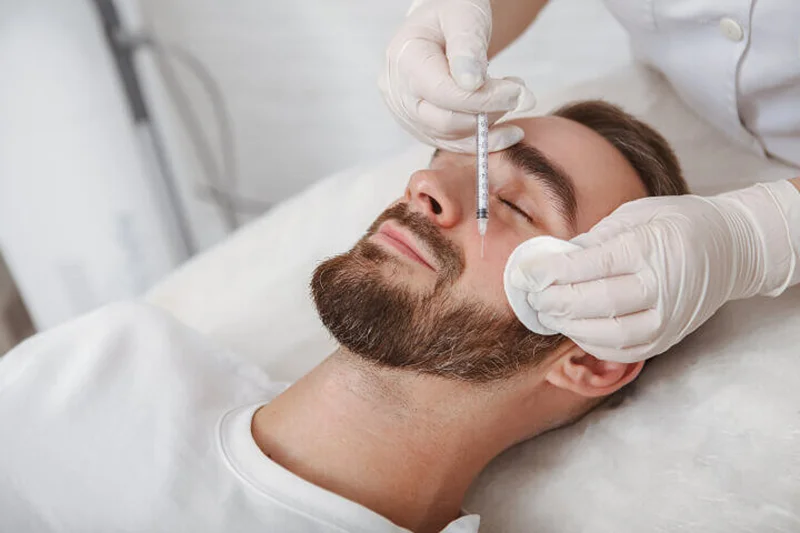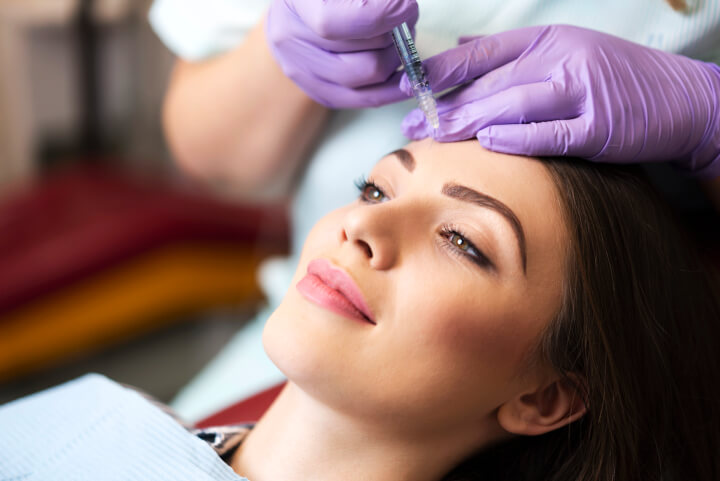Bolus Injection vs Serial Puncture Technique for Dermal Fillers

Lost volumes in the face and perioral region cause excessive skin folds, fine lines, and wrinkles, giving people an older appearance. To counter this, dermal filler injections have been used to fix cosmetic flaws on the face that indicate aging. These fillers can either be synthetic or natural substances that are infused into the dermal layer of the skin to restore facial volume loss and reduce the appearance of wrinkles and fine lines. Since the FDA authorized the first collagen filler in 1981, facial fillers for thickening facial rhytids became popular.
So which is the better technique for injectable fillers between bolus and serial puncture? Linear threading, serial puncture, and bolus injections are all suitable filler techniques. Though linear threading may generally be the best option, the serial puncture is most frequently used for facial filler injection. Serial punctures are usually done on the eyelids and forehead while linear threading or crosshatching is done mostly at the mentolabial fold (within the chin area, just below the lips).
What is your perfect cosmetic filler? Whether in your lips, cheeks, or anywhere else, our providers know exactly how to make you look your best. Call us today to learn more.
Bolus Injection vs Serial Puncture Technique
Depending on the volume loss and fat pad depletion, experienced practitioners may conduct superficial injections or deep dermis injections in that area. The general principle is that the amounts of filler or volume replacement required are proportional to the appearance of vasculature in that region.
When the practitioner knows the depth of placement of the soft tissue fillers, the technique of intravascular injection becomes simpler. The injectable fillers’ depth and the vascular system in the area determine whether they’ll use a needle or cannula. Cannulas are usually believed to be less painful and safer, but this is not always the case.
The placement and series of the tiny bolus injections in specific locations will support and anchor the face. Reducing the volume of product used is also advisable while still achieving the optimal results by injecting in a sequence pattern. Point lifts in filler treatments are becoming more popular due to the following benefits:
- Injection points that are both precise and focal
- Long-term work, small volume, evaluated buildup
- More longevity with deep or subperiosteal filling
- Less expensive
These injections are typically performed with pointed needles rather than cannulas, are often bolus single or multiple, smaller or larger, and are primarily placed in the subcutaneous layer or the subdermal plane. Deep volume restoration is done first, then superficial placement.
As a result, the depth of injection arrangement is shifted from the superficial plane to the deep plane. It provides deep support to the overlying frameworks while also replenishing the volume of subcutaneous tissue. These basic techniques obtain a repletion pattern with prime fillers on the skin.
The injector employs fewer volumes on their aged appearance, a high G prime, and tactical positioning of lateral to medial, deep to superficial, and superior to inferior to develop liquid facelift for a youthful appearance.
Bolus injections treat the submalar area or the nasolabial fold, the chin, cheeks, temple, and point lifts. Another method is a fractional micro depot when a large bolus must be prevented and is typically performed in the periorbital region in a retrograde fashion.
Learn More: Injectable vs Non-Injectable Dermal Fillers: Which is Better?
Common Injection Sites
The following zones below are essential to consider when administering a filler injection technique:
Nasolabial fold: The angular artery or lateral nasal artery is responsible for the nasolabial fold. It is best to keep superficial when injecting in the lower portion of the nasolabial fold, and deep or preperiosteal plane injections are safest in the top third of the fold.
Nasal tip: The angular artery runs through the direction of the nose. Because the vessels in this area are superficial, it is ideal for injecting on the cartilage or bone rather than the nasal tip to avoid puncturing the lateral nasal artery.
Infraorbital: To avoid infraorbital blood vessels, an individual must remain lateral to the infraorbital foramen while injecting to the malar zone.
Glabellar region: Supratrochlear and supraorbital nerves run through the glabella. Injecting filler intravenously in this area must be avoided, or only injecting superficially.
Temple: The temporal artery is linked to the internal carotid structure and the central retinal artery at the temple.
Lips: The superior and inferior branches of the labial arteries Injections in the lips must be less than 3 mm deep and subcutaneous at the commissures.
Other Injection Techniques
Some of the most widely used facial filler injection and lip enhancement techniques are enumerated below as traditional injection methods. Although certain regions and instances may necessitate a particular variety of injection techniques, the facial filler is generally given using a combination of tunneling, point, stretching, or dual plane techniques.
Novice injectors must not view these techniques as separated, single methods because they are frequently used in conjunction inside a single injection site. Several methods for injecting dermal fillers have been discussed. The injection depth is determined by the type of filler and the desired results.
Linear threading
As the syringe is withdrawn in linear threading, a passageway of filler is infused to smooth out the wrinkle. This method is frequently used to treat separated creases like marionette lines or nasolabial folds. The Tyndall effect occurs in this procedure due to the superficial filler injection right at the end of the syringe withdrawal process.
Crosshatching
Cross hatching is based on linear filling, which involves injecting filler into a sequence of parallel tunnels. The crosshatching is then created by injecting perpendicular passageways. This procedure is designed for filling in larger areas.
The Dual Plane Method
The dual-plane method includes injecting facial filler into two different levels of the skin in a single area. The dermis, or the middle part of the skin, is the most commonly affected area. Doctors will place the filler to the subcutaneous plane to supplement this preliminary injection, a level straight beneath the skin.
In some cases, they use two different kinds of dermal fillers to fill the two various planes. They apply a thinner to the superficial, skin-level injection while a denser filler for the subdermal plane.
Specialists use the dual-plane method in two distinct situations. For starters, if a patient has a desired location that’s constantly moving, the dual plane technique can produce a more natural outcome across all possible facial expressions. The dual-plane approach is beneficial when solving a region with both superficial wrinkles and deep facial volume loss.
Point Technique
The point method, also identified as the “droplet,” “multi-puncture,” “serial” technique, entails injecting a few tiny droplets of filler to the different levels of the deep dermis, or the subcutaneous region.
Rather than injecting all of the filler simultaneously, the point method utilizes a series of microinjections close together. The filler drops coalesce to elevate the wrinkle and make its curves less noticeable, while several infusions are closer together.
Radial fanning
Radial fanning’s purpose is to fill the trouble area with tiny skin pricks to minimize bruising. A thin needle into the targeted region, and as the syringe is withdrawn, a passageway of filler is infused. Before the syringe is removed from the skin, it is rerouted into a different radial plane, and much more filler is infused until the desired result is attained.
Stretching Method
Prior to injecting the filler, the injector will stretch the tissue surrounding the targeted wrinkle to separate the treatment area using the stretching technique. This integration of pressure and stretching application will make needle placement and angulation simpler and more accurate, leading to better representation through the skin.
All of this can help guarantee the accuracy of placing filler where it is necessary. Stretching is most frequently used in regions with more skin laxity or redundancy, for understandable reasons, like managing superficial wrinkles around the corner of the lips.
Read More: The Best Strategy For Men’s Botox And Dermal Fillers
Possible Complications and Allergic Reactions

The infusion of soft-tissue fillers has been linked with a range of health problems. Complications resulting from using non-absorbable fillers are more challenging to handle because they are not digested and may require expunging.
It can lead to unsightly scarring and, eventually, poor beauty results. Generally, hyaluronic acid filler side effects can slow down using hyaluronidase, giving the healthcare providers a significant advantage in managing risks.
Infection at the site of injection
Experiencing an infection at the injection site is an unusual filler complication. Microbial, viral, or Candida species may be responsible for this. Herpes simplex is the most common viral infection that spreads to injection sites. This is much more frequent among patients who have a record of cold sores.
To minimize the risk of complications, consider pretreatment with valacyclovir, acyclovir, or famciclovir. Keep a low limit for full ophthalmologic assessment if there is any suspicion of herpes virus ocular involvement.
Treatment includes cut and drainage and oral antibiotics for abscesses to protect widely known skin flora and gram positives if cellulitis is a problem. People should avoid hyaluronidase whenever there is a presumption of infection, as this may spread the infection through the connective tissue.
Bruises
The most common side effect of fillers is injection site bruising. It can happen despite the method employed. But even so, the respective precautions can avoid or reduce bruising:
- Inform patients that they must avoid blood thinners (anti-inflammatory drugs, warfarin, aspirin, clopidogrel, dabigatran, non – steroidal, fish oil, garlic, ginkgo, ginseng, or vitamin E) for at least one week before the treatment.
- Prefer needles with small gauges as well as blunt cannulas.
- Cut down the number of injection sites as much as possible.
- Immediately apply pressure to the region and place an ice pack if bruising is observed or presumed at the moment of injection.
- Inform patients to stop activities that will raise their blood pressure or put stress on their face and head for the next 24 hours.
- Advise patients that they must keep their heads elevated for 24 hours following injection.
Granulomatous inflammation
Any filler can cause granulomatous inflammation. True granulomas caused by fillers will almost certainly include several injection sites. Solitary nodules are almost certainly not actual granulomatous responses. People may use gradual infusions of one of the anti-inflammatory medicines, triamcinolone, Kenalog, or 5-fluorouracil, over a couple of weeks to months.
Biofilms
Biofilms can form due to an implantable medical device or foreign substances injected inside the body. They let the bacteria lie dormant for an extended period before awakening to induce abscess formation, cellulitis, or granulomatous reactions.
Consult the Experts at aNu Aesthetics

Facial fillers are an effective treatment for facial wrinkles, volume loss, and facial lines. While different fillers and injection methods have different purposes, all facial filler injections provide patients a more rejuvenated and youthful look to make them feel more confident about themselves. Contact us today or visit our store for a consultation.
What is your perfect cosmetic filler? Whether in your lips, cheeks, or anywhere else, our providers know exactly how to make you look your best. Call us today to learn more.